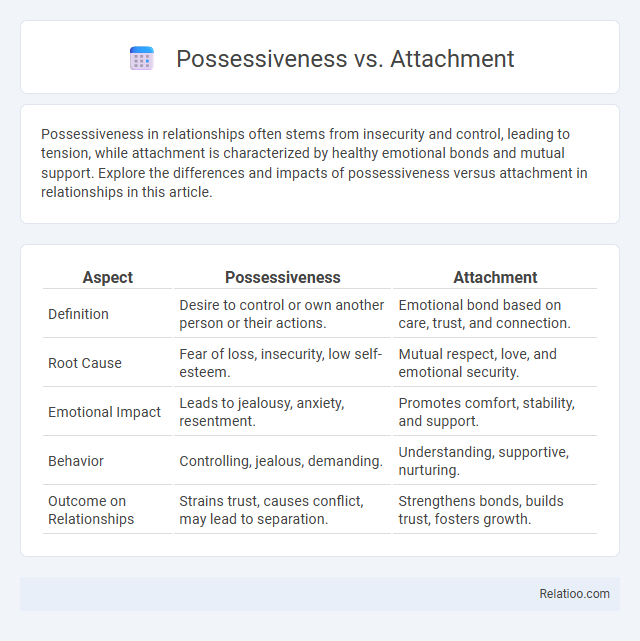Possessiveness in relationships often stems from insecurity and control, leading to tension, while attachment is characterized by healthy emotional bonds and mutual support. Explore the differences and impacts of possessiveness versus attachment in relationships in this article.
Table of Comparison
| Aspect | Possessiveness | Attachment |
|---|---|---|
| Definition | Desire to control or own another person or their actions. | Emotional bond based on care, trust, and connection. |
| Root Cause | Fear of loss, insecurity, low self-esteem. | Mutual respect, love, and emotional security. |
| Emotional Impact | Leads to jealousy, anxiety, resentment. | Promotes comfort, stability, and support. |
| Behavior | Controlling, jealous, demanding. | Understanding, supportive, nurturing. |
| Outcome on Relationships | Strains trust, causes conflict, may lead to separation. | Strengthens bonds, builds trust, fosters growth. |
Understanding Possessiveness: Key Traits
Understanding possessiveness involves recognizing key traits such as an intense need to control and a fear of losing what is perceived as belonging to oneself. Unlike attachment, which denotes emotional bonding and connection, possessiveness is marked by jealousy, insecurity, and a desire to dominate. Identifying these traits is crucial for differentiating possessiveness from healthy attachment and fostering balanced relationships.
Defining Attachment in Relationships
Attachment in relationships refers to the emotional bond that connects you to another person, fostering security, trust, and mutual support. Unlike possessiveness, which is rooted in control and fear of loss, attachment emphasizes healthy interdependence and emotional closeness without restricting individual freedom. Understanding attachment helps promote balanced relationships where both partners feel valued and connected without feeling constrained.
Psychological Roots of Possessiveness
The psychological roots of possessiveness often stem from underlying insecurities, fears of abandonment, and low self-esteem, which drive individuals to tightly control relationships or objects to feel safe. Attachment styles, particularly anxious or insecure attachment, play a crucial role in how possessiveness manifests, differentiating it from healthy attachment where trust and mutual respect exist. You can better understand possessiveness by recognizing these emotional foundations, allowing for healthier interpersonal boundaries and emotional regulation.
Healthy vs Unhealthy Attachment Patterns
Healthy attachment fosters trust and emotional security, allowing you to maintain individuality while forming close bonds. Unhealthy attachment often manifests as possessiveness, characterized by jealousy, control, and fear of abandonment, undermining relationship stability. Recognizing these patterns helps promote balanced connections that support mutual growth and respect.
Signs of Possessiveness in Partners
Signs of possessiveness in partners include constant monitoring of your whereabouts, excessive jealousy over interactions with others, and controlling behavior that limits your freedom. They may frequently demand updates, show insecurity-driven accusations, or react aggressively to perceived threats. Recognizing these behaviors early helps distinguish unhealthy possessiveness from healthy attachment and fosters boundaries for emotional well-being.
Attachment Styles and Emotional Bonds
Attachment styles influence emotional bonds by shaping how individuals connect and respond to intimacy, with secure attachment fostering healthy dependability and avoidant or anxious styles leading to insecurity or clinginess. Possessiveness often arises from insecure attachment, manifesting as controlling behavior to alleviate fears of rejection or abandonment. Understanding the distinction between possessiveness, which restricts autonomy, and secure emotional attachment, characterized by trust and mutual respect, is crucial for nurturing balanced relationships.
Impacts of Possessiveness on Relationships
Possessiveness in relationships often leads to excessive control, jealousy, and mistrust, which can erode emotional intimacy and create tension between partners. Unlike healthy attachment, which fosters security and mutual respect, possessiveness imposes restrictions that hinder your partner's independence and personal growth. Recognizing and managing possessive tendencies is crucial to maintaining a balanced, trusting relationship that supports both individuals' well-being.
Nurturing Secure Attachment
Nurturing secure attachment involves fostering emotional bonds characterized by trust and safety rather than possessiveness or unhealthy attachment. You can support this by encouraging open communication, empathy, and consistent responsiveness to your loved one's needs. Distinguishing between possessiveness, which often leads to control and anxiety, and secure attachment is crucial for maintaining healthy, balanced relationships.
Overcoming Possessiveness: Practical Steps
Overcoming possessiveness requires recognizing the difference between healthy attachment and controlling behavior that undermines trust in relationships. You can practice mindfulness, enhance communication skills, and establish personal boundaries to reduce feelings of insecurity and dependency. Developing self-awareness and fostering emotional independence are key steps to transforming possessiveness into a balanced, nurturing connection.
Building Trust and Emotional Connection
Possessiveness often stems from insecurity and can hinder building trust by creating feelings of control rather than emotional safety. Attachment, especially secure attachment, fosters emotional connection by encouraging mutual understanding and respect. Developing healthy emotional bonds requires distinguishing possessiveness from genuine care to promote trust and emotional intimacy.

Infographic: Possessiveness vs Attachment
 relatioo.com
relatioo.com